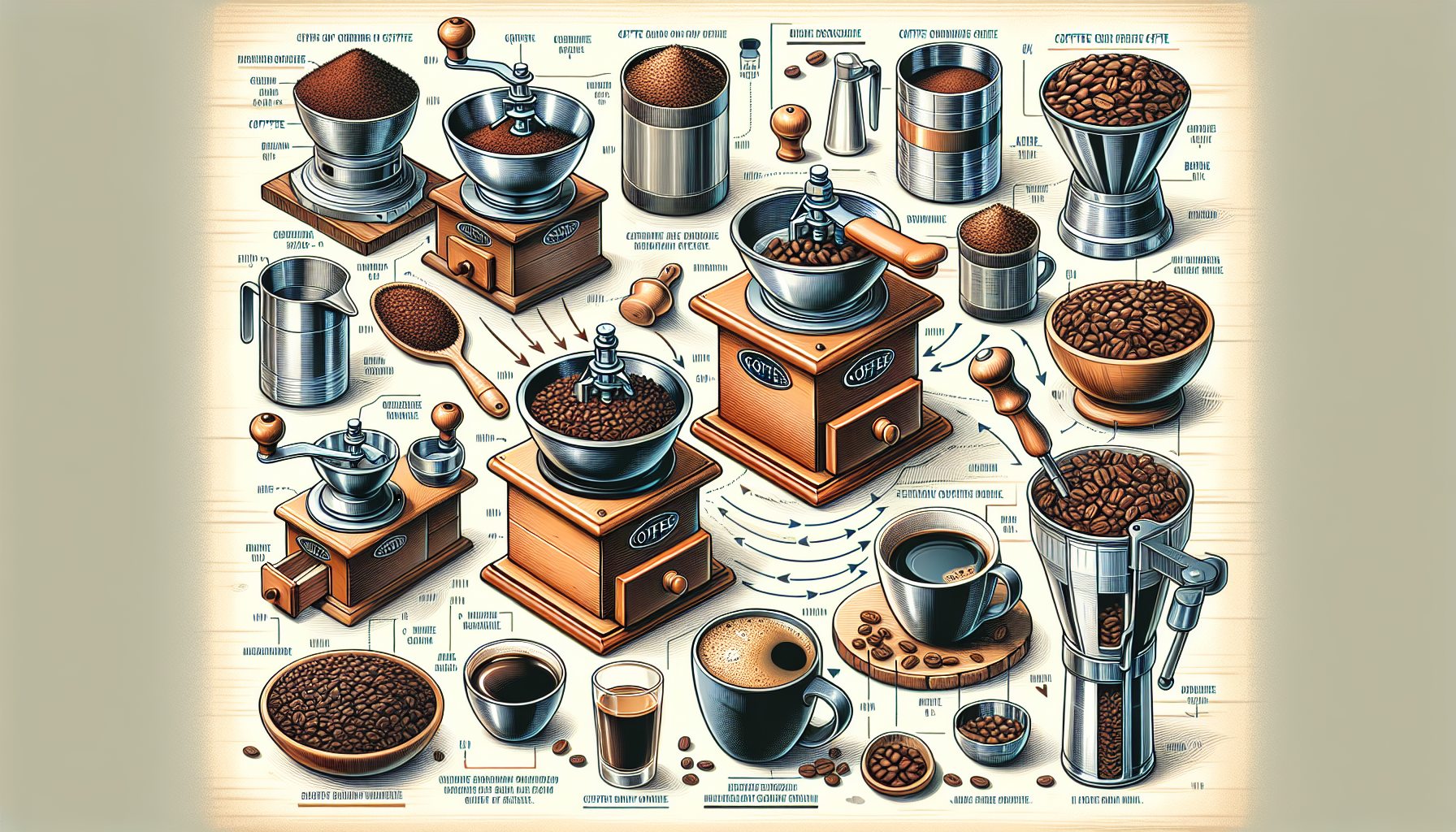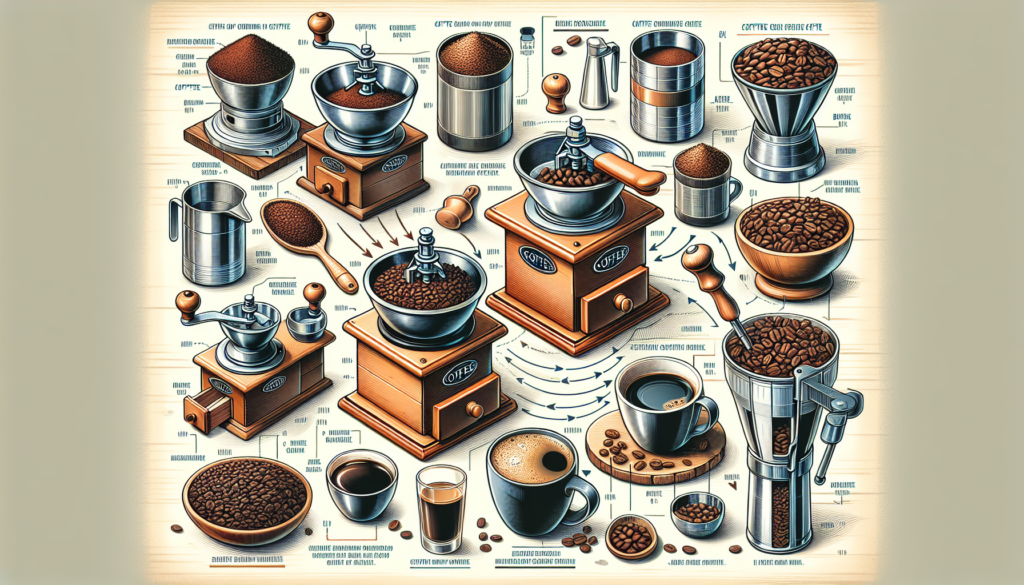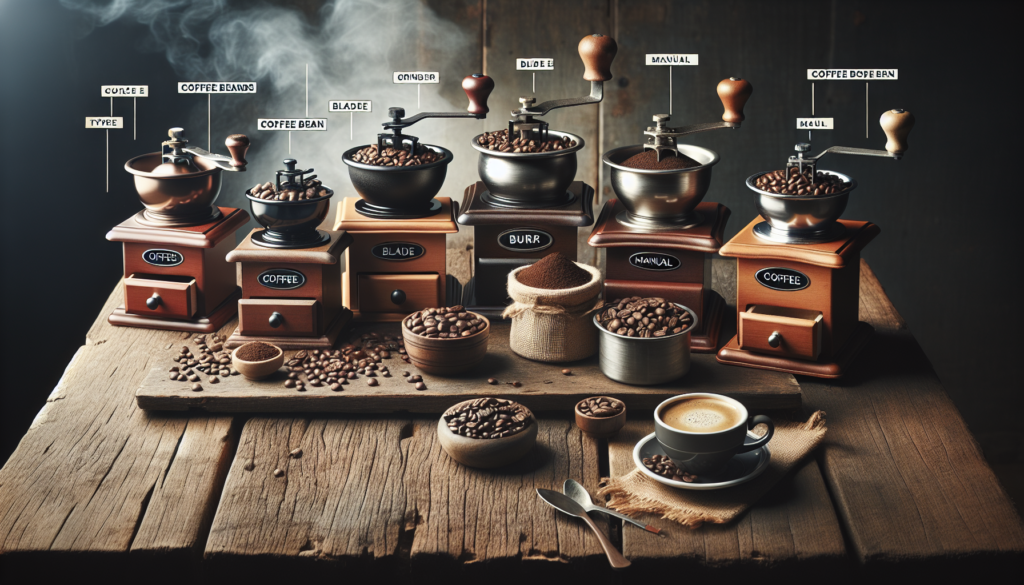
Are you a coffee aficionado who loves experimenting with different types of beans? Then you’ll agree that the choice of coffee grinder can make all the difference in the flavor and aroma of your brew. In this article, we explore the fascinating relationship between coffee grinder types and bean varieties. Discover how different grinder types, such as blade grinders and burr grinders, can impact the taste profile of various bean varieties, from light and fruity to dark and bold. Get ready to elevate your coffee experience to a whole new level of deliciousness!

Blade Grinders
Definition
Blade grinders are the most basic and common type of coffee grinder. They operate by using a spinning blade to chop the coffee beans into smaller pieces. The size of the grounds is determined by the length of time the grinder is run.
Advantages
One of the main advantages of blade grinders is their affordability. They are often the least expensive option on the market, making them accessible to a wide range of coffee enthusiasts. Blade grinders are also relatively small and compact, making them easy to store and transport. Moreover, they are simple to use, requiring minimal effort to operate.
Disadvantages
Despite their affordability and convenience, blade grinders have some limitations. First and foremost, they tend to produce uneven grounds. The spinning blade can result in an inconsistent grind size, which can negatively affect the extraction and flavor of the coffee. Additionally, the friction generated by the blades can generate heat, potentially damaging the coffee grounds and compromising the quality of the final brew.
Burr Grinders
Definition
Burr grinders are considered the gold standard in the coffee grinding world. These grinders utilize two spinning burrs, either conical or flat, to crush the coffee beans into a consistent grind size.
Advantages
The main advantage of burr grinders is their ability to produce a uniform grind size. This consistency enhances the extraction process and allows for a more balanced and flavorful cup of coffee. Additionally, burr grinders offer a wide range of grind size settings, allowing for customization based on personal preferences and brewing methods. They are also relatively easy to use and maintain.
Disadvantages
One potential downside of burr grinders is their higher price point compared to blade grinders. The precision and quality construction of burr grinders contribute to their increased cost. Furthermore, burr grinders tend to be larger and bulkier than blade grinders, requiring more storage space. However, for coffee enthusiasts looking for the best flavor and consistency, the investment in a burr grinder is well worth it.
Impact Grinders
Definition
Impact grinders, also known as hammer mills, are less commonly used for coffee grinding. They work by pulverizing the coffee beans between rotating blades and a stationary grinding chamber.
Advantages
One advantage of impact grinders is their speed. They are capable of grinding a large quantity of coffee beans quickly, which can be beneficial in commercial settings. Additionally, impact grinders are often more affordable than burr grinders, making them an option for those on a budget.
Disadvantages
While impact grinders may be fast and cost-effective, they have significant drawbacks when it comes to coffee quality. The high-speed grinding process generates a considerable amount of heat, which can negatively impact the flavor and aroma of the coffee. Furthermore, impact grinders tend to produce more inconsistent grind sizes, leading to uneven extraction and potentially bitter-tasting brews.

Heat and Consistency
Impact of Grinder Type on Heat Generation
The heat generated during the grinding process can have a profound impact on the quality of the coffee. Blade grinders, due to their high-speed spinning blades, generate the most heat among the three types. This heat can potentially scorch the coffee grounds, resulting in a burnt or off-flavored brew. Burr grinders, on the other hand, produce much less heat, thanks to their slow and precise crushing mechanism. The reduced heat generation helps preserve the delicate flavors and aromas of the coffee beans.
Impact of Grinder Type on Consistency
Consistency in grind size is crucial for ensuring optimal extraction and flavor. Blade grinders, with their spinning blades, often produce an uneven grind—ranging from coarse to fine particles within the same batch. This inconsistency can lead to over-extraction of smaller particles and under-extraction of larger ones, resulting in an imbalanced cup of coffee. Burr grinders, however, excel in producing a consistent grind size. The precisely aligned burrs crush the beans uniformly, allowing for a more even extraction and a well-balanced flavor profile.
Extraction and Flavor
Blade Grinder Effects on Extraction and Flavor
Blade grinders can negatively impact the extraction process and the resulting flavor of the coffee. Uneven grind sizes can lead to over-extraction or under-extraction, causing bitterness or weak flavor respectively. The heat generated by blade grinders can also alter the flavor profile, potentially resulting in a burnt or unpleasant taste. Overall, using a blade grinder may compromise the full potential of the coffee’s flavor and complexity.
Burr Grinder Effects on Extraction and Flavor
Burr grinders are renowned for their ability to enhance extraction and flavors. The consistent grind size produced by burr grinders ensures even extraction, leading to a well-balanced cup of coffee. This consistency allows for better control over brewing variables, resulting in a more nuanced and flavorful brew. Additionally, the gentle crushing action of burr grinders minimizes heat generation, preserving the delicate flavors and aromas of the coffee beans.
Impact Grinder Effects on Extraction and Flavor
Impact grinders, with their high-speed grinding mechanism, can negatively impact the extraction and flavor of the coffee. The inconsistent grind size produced by impact grinders may lead to uneven extraction, resulting in variations in flavor intensity. Furthermore, the heat generated by the rapid grinding process can alter the delicate compounds in the coffee, leading to a less nuanced and potentially bitter brew. As a result, impact grinders may not provide the optimal extraction and flavor experience, particularly for those seeking a more refined coffee experience.
Bean Varieties and Grinder Types
Light Roast Beans and Grinder Types
For light roast beans, which tend to have a more delicate flavor profile, the choice of grinder type becomes crucial. Blade grinders, due to their inconsistent grind size and heat generation, may struggle to extract the nuanced flavors from light roast beans fully. Burr grinders, on the other hand, excel in producing a consistent grind size and minimizing heat, allowing for better extraction and preserving the delicate flavors of light roast beans.
Medium Roast Beans and Grinder Types
Medium roast beans offer a balance of flavor and strength. Both blade and burr grinders can produce satisfactory results with medium roast beans. However, burr grinders with their consistent grind size and better control over extraction variables will likely result in a more refined and flavorful cup of coffee compared to blade grinders.
Dark Roast Beans and Grinder Types
Dark roast beans are known for their bold and robust flavors, often accompanied by a slightly oily surface. Blade grinders can handle the dark roast beans adequately, as the heat generated can enhance the extraction of the smoky and caramelized notes. However, burr grinders still offer the advantage of producing a consistent grind size, allowing for better control over extraction and minimizing the risk of over-extraction and bitterness.
Grind Size and Grinder Types
Coarse Grind and Grinder Types
Coarse grind is typically used for brewing methods like French press or cold brew, where a larger particle size is desired. Blade grinders may struggle with producing a consistent coarse grind, resulting in a mix of finer and coarser particles. Burr grinders, with their precise grind size settings, excel in producing a uniform coarse grind, ensuring even extraction and a well-balanced flavor.
Medium Grind and Grinder Types
Medium grind is common for brewing methods such as drip coffee or pour-over. Blade grinders can produce a passable medium grind, but the inconsistency in grind size may still impact the extraction and flavor. Burr grinders, with their ability to create a consistent medium grind, offer better control over extraction variables, resulting in a more flavorful and well-rounded cup of coffee.
Fine Grind and Grinder Types
Fine grind is necessary for brewing methods like espresso, Turkish coffee, or Moka pot. Blade grinders are generally not recommended for fine grinding due to their inconsistent grind size and potential heat generation. Burr grinders, with their precise grind size settings and minimal heat output, excel in producing a consistent fine grind, allowing for optimal extraction and the rich, intense flavors associated with these brewing methods.
Specialty Coffee and Grinder Types
Single-Origin Specialty Coffee and Grinder Types
Single-origin specialty coffees are known for their unique flavors and distinct characteristics. To fully experience the nuances and complexities of such coffees, a burr grinder is highly recommended. The consistency and control offered by burr grinders allow for the optimal extraction of the intricate flavors and aromas present in single-origin coffees, resulting in an exceptional and satisfying cup of coffee.
Blends and Grinder Types
Blends often aim to create a balanced and harmonious flavor profile by combining different coffee beans. Both blade and burr grinders can handle grinding coffee blends effectively. However, if the blend consists of varying bean types or roast levels, a burr grinder may provide better consistency and control over extraction variables, ensuring a well-balanced and enjoyable cup of coffee.
Espresso Beans and Grinder Types
Espresso beans require a fine and consistent grind size to achieve the desired extraction and flavor concentration. Blade grinders are generally not recommended for espresso, as their inconsistent grind size can lead to inconsistent extraction. Burr grinders, specifically those designed for espresso, offer precise grind size settings and uniform grinding, allowing for the optimal extraction of the rich and intense flavors associated with espresso.
Price and Grinder Types
Best Grinder Types at Different Price Points
When considering price points, blade grinders tend to be the most affordable option, making them accessible to budget-conscious coffee lovers. However, for those seeking the best flavor and consistency, burr grinders are worth the investment. While burr grinders may come at a higher price, they offer superior control over grind size, extraction, and overall coffee quality.
Value for Money considering Grinder Types
When evaluating the value for money, it is important to consider the long-term benefits of a burr grinder. While initially more expensive, burr grinders provide a consistent grind size, better control over extraction, and preserve the delicate flavors of the coffee beans. Investing in a burr grinder ensures a more enjoyable and flavorful coffee experience, making it a valuable investment for coffee enthusiasts seeking a high-quality brew.
Maintenance and Grinder Types
Cleaning and Upkeep for Different Grinder Types
Blade grinders are relatively easy to clean, as they usually have removable blades that can be detached for thorough cleaning. However, extra care should be taken to remove any coffee grounds left in the grinder since they can accumulate and affect the flavor of future brews. Burr grinders require regular cleaning to prevent coffee bean residue from clogging the burrs. Cleaning procedures may vary depending on the specific model, so it is recommended to follow the manufacturer’s guidelines for proper maintenance.
Longevity and Durability of Grinder Types
Burr grinders, with their precision engineering and sturdy construction, tend to be more durable and long-lasting compared to blade grinders. The high-quality materials used in burr grinders contribute to their longevity, ensuring years of reliable performance. Blade grinders, while generally less expensive, may have a shorter lifespan due to the wear and tear on the spinning blades. Regular maintenance and careful handling can help extend the lifespan of both types of grinders.